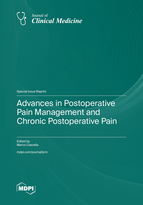Advances in Postoperative Pain Management and Chronic Postoperative Pain
A special issue of Journal of Clinical Medicine (ISSN 2077-0383). This special issue belongs to the section "Anesthesiology".
Deadline for manuscript submissions: closed (25 May 2023) | Viewed by 29099
Special Issue Editor
Interests: awareness anesthesia; anesthesia brain monitoring; memory and anesthesia; postoperative delirium; postoperative cognitive dysfunction; opioids research; pain assessment
Special Issues, Collections and Topics in MDPI journals
Special Issue Information
Dear Colleagues,
Acute pain is usually associated with a specific illness or trauma. It is expected to be limited to its time to repair the damage. The most characteristic acute pain is postoperative pain (POP). It is generally predictable and characterized by its strong intensity and short duration. The clinical features of POP vary from subject to subject and in the same patient over time. This variability is due to the pre-existing pathology and location, type, and invasiveness of the surgery. However, the characteristics of POP also depend on other components, such as psychological factors that intersect with cultural, religious, socio-economic aspects, and others.
Clinically, POP involves a constellation of unpleasant sensory and emotional experiences associated or not with autonomic and behavioral responses. The complex humoral responses that initially work to maintain the homeostasis, when excessive and prolonged, can cause organic, psychological, and behavioral alterations (e.g., anxiety, insomnia, depression, etc.) and can become particularly difficult to treat. Consequently, if not properly treated, POP can assume the characteristics of a complex chronic pain issue. Remarkably, chronic POP (CPOP) is defined by painful symptomatology in the operated area unrelated to previous pain, present for more than 3 months, and without any link to surgical complications.
This Special Issue will identify the gaps in the prevention, diagnosis, and management of POP/CPOP based on a combination of original research and review papers.
Topics will include:
- The epidemiology of POP/CPOP;
- The role of genetics and other mechanisms involved in the development of POP and its chronicization (preclinical research);
- Clinical features of POP in different populations (e.g., in children) and surgical settings (e.g., robotic surgery);
- Diagnostic approaches;
- Prevention of POP/CPOP;
- Interventions for POP/CPOP management.
- Psychological issues;
- New strategies useful for diagnosis and therapy (e.g., AI-based approaches).
Dr. Marco Cascella
Guest Editor
Manuscript Submission Information
Manuscripts should be submitted online at www.mdpi.com by registering and logging in to this website. Once you are registered, click here to go to the submission form. Manuscripts can be submitted until the deadline. All submissions that pass pre-check are peer-reviewed. Accepted papers will be published continuously in the journal (as soon as accepted) and will be listed together on the special issue website. Research articles, review articles as well as short communications are invited. For planned papers, a title and short abstract (about 100 words) can be sent to the Editorial Office for announcement on this website.
Submitted manuscripts should not have been published previously, nor be under consideration for publication elsewhere (except conference proceedings papers). All manuscripts are thoroughly refereed through a single-blind peer-review process. A guide for authors and other relevant information for submission of manuscripts is available on the Instructions for Authors page. Journal of Clinical Medicine is an international peer-reviewed open access semimonthly journal published by MDPI.
Please visit the Instructions for Authors page before submitting a manuscript. The Article Processing Charge (APC) for publication in this open access journal is 2600 CHF (Swiss Francs). Submitted papers should be well formatted and use good English. Authors may use MDPI's English editing service prior to publication or during author revisions.
Keywords
- postoperative pain
- chronic postoperative pain
- pain mechanisms
- postoperative pain management
- physiopathology of chronic postoperative pain
- local anesthetics
- non-invasive analgesic procedures
- opioids







